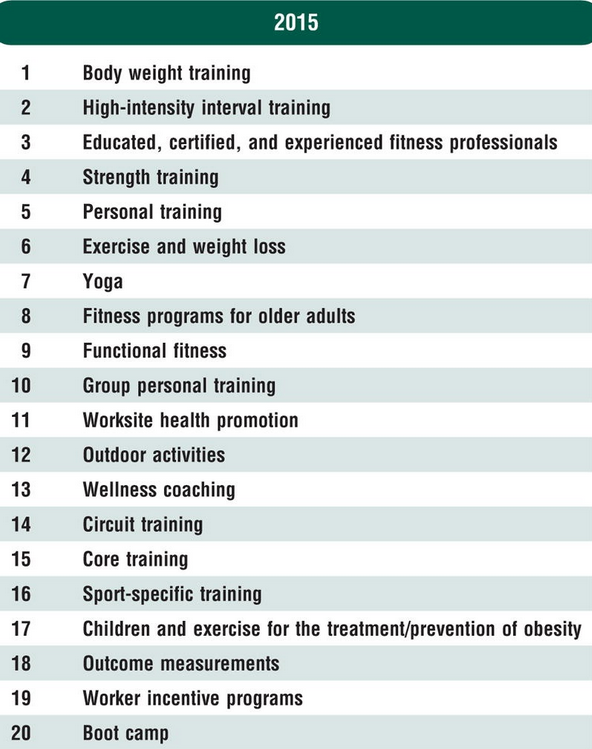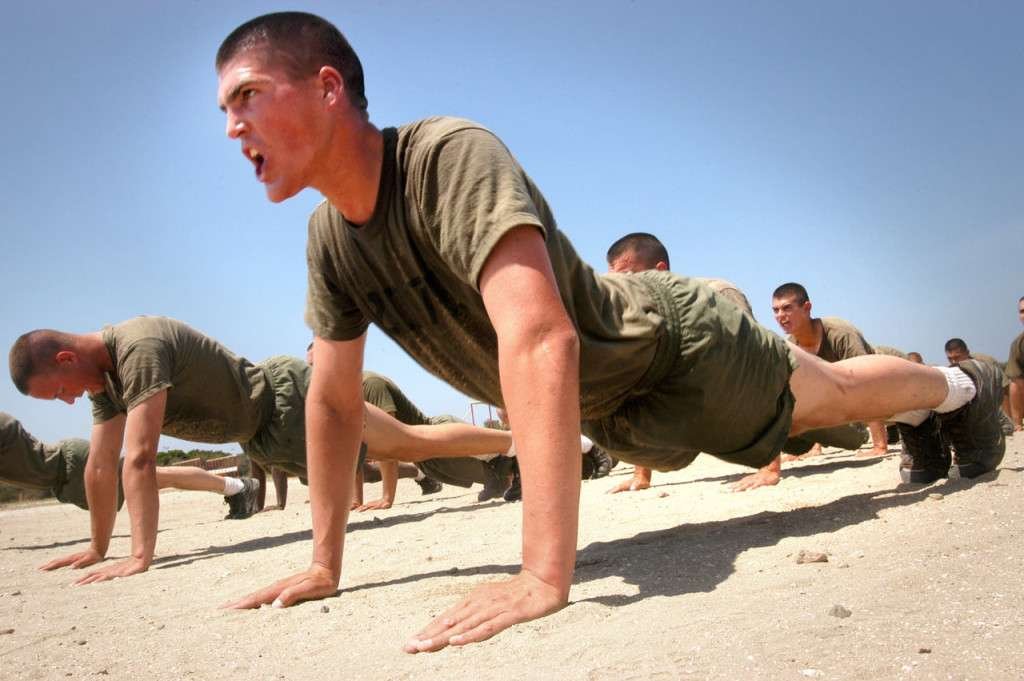HIIT Still Number 1
In the press release launching the American College of Sports Medicine’s 2015 survey of Fitness Trends for 2015 HIIT had slipped to number 2. All is not what it seems.
HIIT first made it into the ACSM annual survey in 2010 coming in as a new entry at #4. Last year it had become #1. This year it is down to #2.
As always, things are not what they seem. This year’s top trend – Bodyweight Training – frequently uses HIIT concepts to get the most out of exercise periods. Everyone recognises that lack of time is a major reason for not exercising. Anything that maximises the outcome from exercise while minimise the time exercising is still a winner.
We are great fans of bodyweight training. It has long been our belief that the vast majority of gym exercise equipment is over-priced, over-engineered and delivers very little positive gain for the majority of people. Using you own bodyweight is a very natural way to exercise. Bodyweight exercises such as:
- Lunges – front and side
- Squats
- Burpees
- Squat thrusts
- Push Ups
- Jumping Jacks
and many, many more are all great HIIT exercises.
Read the 2015 Fitness Trends Press Release below. Let us know what you think.
Survey Predicts Top 20 Fitness Trends for 2015
For Immediate Release: October 24, 2014
INDIANAPOLIS – Push-ups, planks, lunges and squats. If you’ve recently incorporated more body weight exercises into your workout routine, you’re part of a growing trend. The American College of Sports Medicine (ACSM) has announced its annual fitness trend forecast based on survey responses from thousands of fitness professionals. The results were released in the article “Worldwide Survey of Fitness Trends for 2015: What’s Driving the Market” published today in the November/December issue of ACSM’s Health & Fitness Journal®.
“It’s no surprise to see body weight training claiming the top spot this year,” said Walter R. Thompson, Ph.D., FACSM, the lead author of the survey. “These kinds of exercises provide the benefit of requiring little to no equipment and are incorporated into many fitness programs that are currently popular.”
Now in its ninth year, the survey was completed by more than 3,400 health and fitness professionals worldwide, many certified by ACSM, and was designed to reveal trends in various fitness environments. Thirty-nine potential trends were given as choices, and the top 20 were ranked and published by ACSM, including a new addition to last year’s list, which rose quickly to the top.
The top 10 fitness trends predicted for 2015 are:
1. Body Weight Training: Body weight training uses minimal equipment making it more affordable. Not limited to just push-ups and pull-ups, this trend allows people to get “back to the basics” with fitness.
2. High-Intensity Interval Training (HIIT): HIIT involves short bursts of activity followed by a short period of rest or recovery. These exercise programs are usually performed in less than 30 minutes.
3. Educated and Experienced Fitness Professionals. Given the large number of organizations offering health and fitness certifications, it’s important that consumers choose professionals certified through programs that are accredited by the National Commission for Certifying Agencies (NCCA), such as those offered by ACSM. ACSM is one of the largest and most prestigious fitness-certification organizations in the world.
4. Strength Training. Strength training remains a central emphasis for many health clubs. Incorporating strength training is an essential part of a complete exercise program for all physical activity levels and genders. (The other essential components are aerobic exercise and flexibility.)
5. Personal Training. More and more students are majoring in kinesiology, which indicates that they are preparing themselves for careers in allied health fields such as personal training. Education, training and proper credentialing for personal trainers have become increasingly important to the health and fitness facilities that employ them.
6. Exercise and Weight Loss. In addition to nutrition, exercise is a key component of a proper weight loss program. Health and fitness professionals who provide weight loss programs are increasingly incorporating regular exercise and caloric restriction for better weight control in their clients.
7. Yoga. Based on ancient tradition, yoga utilizes a series of specific bodily postures practiced for health and relaxation. This includes Power Yoga, Yogalates, Bikram, Ashtanga, Vinyasa, Kripalu, Anurara, Kundalini, Sivananda and others.
8. Fitness Programs for Older Adults. As the baby boom generation ages into retirement, some of these people have more discretionary money than their younger counterparts. Therefore, many health and fitness professionals are taking the time to create age-appropriate fitness programs to keep older adults healthy and active.
9. Functional Fitness. This is a trend toward using strength training to improve balance and ease of daily living. Functional fitness and special fitness programs for older adults are closely related.
10. Group Personal Training. In challenging economic times, many personal trainers are offering more group training options. Training two or three people at a time makes economic sense for the trainer and the clients.
The full list of top 20 trends is available in the article “Worldwide Survey of Fitness Trends for 2015: What’s Driving the Market.”
-30-
The American College of Sports Medicine is the largest sports medicine and exercise science organization in the world. More than 50,000 international, national and regional members and certified professionals are dedicated to advancing and integrating scientific research to provide educational and practical applications of exercise science and sports medicine.
ACSM’s Health & Fitness Journal® is an official publication of the American College of Sports Medicine, visit www.acsm-healthfitness.org for more information. This journal is available from Wolters Kluwer Health/Lippincott Williams & Wilkins at 1-800-638-3030.


